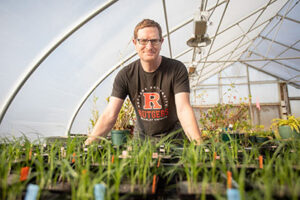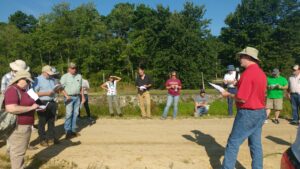Welcome to the inaugural post of our new occasional feature: Meet Our Researchers! We’ve spent so much time talking about the excellent work being done at the Rutgers Philip E. Marucci Center for Blueberry & Cranberry Research that we thought it was time to learn a little more about the people behind the projects. This week: Dr. Thierry Besançon. For a close-up look at his work, check out the Weed Science Instagram account!
What drew you to your field/research focus?
I worked for 10 years in France on diseases and pest management research in stone fruit crops (peaches, plums, cherries…). So, I already had some type of connection with specialty crops before moving to the United States in 2010. In North Carolina, I was offered the opportunity to conduct research for getting a PhD, but I wanted to see and do something new… that’s when I decided to specialize in weed science. I thought it would be good to add weed science knowledge to what I already knew in pathology / entomology from my previous professional experience in Europe. When I joined Rutgers in 2016, I was delighted to be able to work again with specialty crops! But the most exciting thing was really working on cranberries… it’s a unique crop with very specific agronomic practices and very specific challenges, especially regarding weed control. Cranberry is a perennial crop, and most of the time, perennial crops have to deal with perennial weeds that are very challenging to control.
What do you consider your best accomplishment?
Over the last few years, I focused a large part of my research program to find solutions for preventing Carolina redroot (a perennial weed!) to outcompete cranberry vines in our New Jersey Cranberry bogs. Carolina redroot is a very troublesome weed… it competes with cranberry for light, nutrient and water and causes drastic yield and berry quality reduction. It is also very attractive as a food source for waterfowl and that is a problem because swans and geese can cause a lot of damage to cranberry vines when feeding on redroot! Yield losses caused by Carolina redroot average $800/acre. And Carolina redroot is only a problem in New Jersey cranberries as this weeds is virtually unknown further north or in Wisconsin!
Our weed science team spent a lot of time evaluating how Carolina redroot is affecting cranberry yield and quality and determining if some of the unique cranberry agronomic practices (flooding, irrigation, sanding…) may help suppressing Carolina redroot. We also evaluated different non-chemical and chemical options that can help controlling this noxious weeds. After 4 years of investigation, we know more about the biology and ecology of Carolina redroot, and we are now able to propose to the New Jersey cranberry growers a strategy to suppress this weed and restore the productivity of infested cranberry bogs. We still have many questions to answer… How does Carolina redroot propagate from bed to bed? Are we helping it to spread into non infested bogs when harvesting cranberries? Can we detect this weed early enough, so we don’t have to rely on using chemicals to control it?
What has been your biggest challenge?
Well, initial research on Carolina redroot was not easy because not many weed scientists have been investigating this species and we really started from scratch. Learning and understanding the cranberry cropping system was not easy because it is a very, very special crop that I could not compare to anything else I was familiar with. But I am lucky to have great people here in New Jersey in our grower community, with Ocean Spray, and Rutgers University who love cranberries and love transmitting their passion for this wonderful crop. I also have a great weed science team with my technician Baylee Carr, my graduate student Maggie Wasacz, and all the people who are working with us during the spring and summer months.
What are your long-term research goals?
With regards to cranberry, one of my long-term research goals is really to keep better understanding the ecology of some of our most troublesome weed species. We really need to know the details of their life and why they like our cranberry beds so much if we want to get a chance to be more efficient at controlling them in the future.
I am also interested at using new imagery and drone technology to improve the early detection of weed infestation in cranberry beds before weeds colonize entire beds after a few years. With early detection, we can focus our weed control strategies where we really need it. For some species, we could potentially avoid the use of herbicides and focus on non-chemical weed management strategies such as tarping, solarization or manual removal if we can detect the weeds early enough before they start getting a large-scale issue. I also think we’ll be looking at new nonchemical tools for controlling weeds… we have ideas regarding the use of electricity for killing the weeds and we may even have a portable prototype for testing this summer.
What do you enjoy most about working with the cranberry community?
All our New Jersey cranberry growers have been very supportive of my research program, and as a junior faculty, this is extremely important to know that my stakeholders are providing this support. I do not have a week without talking to one of our New Jersey growers or our Ocean Spray agronomists. We are doing applied research in my lab, and it is very important to stay connected with the reality and the challenges that growers are facing with weeds in their cranberry beds. That is very important to have this permanent link with our cranberry community because these discussions are feeding ideas for developing new research!
More personally, our New Jersey cranberry community has been very welcoming and kind with me. I remember one day in my 1st year when I forgot to fill up my gas tank and stopped in Chatsworth, knowing that I could not make it up to the research station. And gas pumps are not very common in the Pine Barrens. It happens that one of our grower give me a call when I was in Chatsworth. He immediately proposed to come to help me with a jerrycan! It is a nice feeling to know that you are working with great professionals but also people that will not hesitate to help you when needed.
*Photos courtesy of Thierry Besançon.


